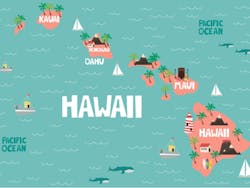In Pro-Microgrid Move, Hawaii Becomes Second State with Microgrid Tariff
In what could be a model for other states, the Hawaii Public Utilities Commission (PUC) has approved a microgrid tariff for its major utilities.
The decision is the culmination of a roughly two-year process, but the PUC is already preparing for a second phase in its development of rules governing microgrids. The first phase centered on rules around microgrids during emergency conditions. The second phase will be looking at microgrid nonemergency operations, including payment for services microgrids can provide.
Utility tariffs are designed to ensure fair compensation for services between parties — in this case, microgrids and utilities, which can each provide services to each other.
“It’s a very big deal that this process is moving forward,” said Cameron Brooks, president of E9 Insight, a regulatory advisory firm that tracks state utility commissions.
Hawaii is the second state to adopt a microgrid tariff behind California, according to Brooks. Puerto Rico is studying the issue, he said.
Through Act 200, signed into law in 2018, Hawaiian lawmakers directed the PUC to develop the tariff to increase resilience and reliability by providing services to the electric grid including energy storage, demand response and other ancillary services, according to Lorraine Akiba, president and CEO of LHA Ventures, a consulting firm, and a former PUC commissioner.
Hawaii sets a model for states
The microgrid tariff sets a path other states can follow, according to Akiba.
“Just as we did with renewable energy and distributed energy resources policies, Hawaii continues to lead and ‘send postcards from the future,’ ” Akiba said.
Join us for an important announcement at Microgrid 2021 on June 3, 12:15 p.m. EST about a new advocacy coalition to advance microgrid policy. Register by June 2 to attend.
“These microgrids are integrating renewable energy, energy storage and distributed energy resources behind the meter to actively include customers in establishing resilience centers and backup power and ancillary services that will support the grid as necessary in emergencies or outages,” Akiba said.
Approved by the commission May 17, the tariff applies to Hawaiian Electric and its subsidiaries, Hawaii Electric Light and Maui Electric, which are collectively called HECO. The utilities serve about 95% of Hawaii’s population.
HECO’s tariff defines two types of microgrids: customer microgrids where all energy comes from utility sources and hybrid microgrids under which consumers supply at least some of their own power.
PUC rejects microgrid caps
In one of the PUC’s key decisions, the commission rejected HECO’s proposal to set a cap on the size of hybrid microgrids, according to Brooks.
The utilities wanted to limit total hybrid microgrids to 6 MW on Oahu, 1 MW on Maui, 1 MW on Hawaii Island, 0.5 MW on Moloka’i and 0.5 MW on Lana’i.
“The companies have not shown a compelling reason to limit deployment of microgrids, and the commission finds no technical basis for a program cap,” the PUC said in its decision.
The PUC also dismissed proposed standby charges for customer microgrids.
In its decision, the PUC approved a Microgrid Participant Bill of Rights proposed by the Division of Consumer Advocacy. The bill of rights, for example, gives a microgrid customer three days to back out of a signed participant contract.
PUC tees up next round of microgrid tariff talks
Cameron Brooks, president of E9 Insight
The decision teed up issues to be tackled in a second phase of the rulemaking process.
The first phase focused on rules around how microgrids would be treated during emergency situations. The PUC said the second phase will look at expanding the tariff to nonemergency situations with a focus on grid services provided by microgrids.
So-called customer microgrids will receive benefits under existing distributed energy resource (DER) programs, according to the commission.
In its current form, the tariff does not appear to provide a way for the operators of hybrid microgrids to receive similar compensation when they are connected to the grid, an issue the PUC wants to take up in the proceeding’s next phase.
Also, the PUC wants to consider how the tariff would apply to various microgrid ownership structures.
Other issues the commission wants to explore in the upcoming rulemaking phase include how the tariff meshes with DERs and integrated grid planning rules, power purchase agreement models, and harmonizing compensation with other grid service mechanisms.
The PUC gave the utilities 10 days from its decision to file a final microgrid tariff.
Long-term outlook
Lorraine Akiba, president and CEO of LHA Ventures
Hawaii has several microgrids and is primed to add more to bolster resiliency in the island state.
Akiba said microgrids will help build a solid foundation for community resilience hubs.
“The microgrids are tools for energy sustainability that will allow the Hawaiian Islands to address, adapt and recover from future disruptions to our island energy systems whether those occur from extreme weather, natural disasters like hurricanes or geopolitical events,” Akiba said.
Hawaii sits in the middle of the Pacific Ocean and each island in the state is a separate island grid with no interconnection, Akiba noted.
“Resilience is a key priority for our communities,” she said.
Track news about microgrid tariffs. Subscribe to the free Microgrid Knowledge Newsletter.


